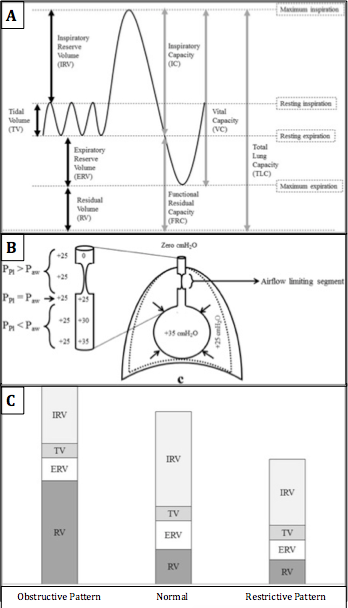[1]
Stocks J, Quanjer PH. Reference values for residual volume, functional residual capacity and total lung capacity. ATS Workshop on Lung Volume Measurements. Official Statement of The European Respiratory Society. The European respiratory journal. 1995 Mar:8(3):492-506
[PubMed PMID: 7789503]
[2]
Lutfi MF. The physiological basis and clinical significance of lung volume measurements. Multidisciplinary respiratory medicine. 2017:12():3. doi: 10.1186/s40248-017-0084-5. Epub 2017 Feb 9
[PubMed PMID: 28194273]
[3]
Rossiter CE, Weill H. Ethnic differences in lung function: evidence for proportional differences. International journal of epidemiology. 1974 Mar:3(1):55-61
[PubMed PMID: 4838716]
[4]
Wanger J, Clausen JL, Coates A, Pedersen OF, Brusasco V, Burgos F, Casaburi R, Crapo R, Enright P, van der Grinten CP, Gustafsson P, Hankinson J, Jensen R, Johnson D, Macintyre N, McKay R, Miller MR, Navajas D, Pellegrino R, Viegi G. Standardisation of the measurement of lung volumes. The European respiratory journal. 2005 Sep:26(3):511-22
[PubMed PMID: 16135736]
[5]
Flesch JD, Dine CJ. Lung volumes: measurement, clinical use, and coding. Chest. 2012 Aug:142(2):506-510. doi: 10.1378/chest.11-2964. Epub
[PubMed PMID: 22871760]
[6]
Coates AL, Peslin R, Rodenstein D, Stocks J. Measurement of lung volumes by plethysmography. The European respiratory journal. 1997 Jun:10(6):1415-27
[PubMed PMID: 9192953]
[7]
Brown R, Leith DE, Enright PL. Multiple breath helium dilution measurement of lung volumes in adults. The European respiratory journal. 1998 Jan:11(1):246-55
[PubMed PMID: 9543301]
[9]
Ruppel GL. What is the clinical value of lung volumes? Respiratory care. 2012 Jan:57(1):26-35; discussion 35-8. doi: 10.4187/respcare.01374. Epub
[PubMed PMID: 22222123]
[10]
Tantucci C, Bottone D, Borghesi A, Guerini M, Quadri F, Pini L. Methods for Measuring Lung Volumes: Is There a Better One? Respiration; international review of thoracic diseases. 2016:91(4):273-80. doi: 10.1159/000444418. Epub 2016 Mar 17
[PubMed PMID: 26982496]
[11]
Pellegrino R, Viegi G, Brusasco V, Crapo RO, Burgos F, Casaburi R, Coates A, van der Grinten CP, Gustafsson P, Hankinson J, Jensen R, Johnson DC, MacIntyre N, McKay R, Miller MR, Navajas D, Pedersen OF, Wanger J. Interpretative strategies for lung function tests. The European respiratory journal. 2005 Nov:26(5):948-68
[PubMed PMID: 16264058]
[12]
Maiolo C, Mohamed EI, Carbonelli MG. Body composition and respiratory function. Acta diabetologica. 2003 Oct:40 Suppl 1():S32-8
[PubMed PMID: 14618430]
[15]
Thomas PS, Cowen ER, Hulands G, Milledge JS. Respiratory function in the morbidly obese before and after weight loss. Thorax. 1989 May:44(5):382-6
[PubMed PMID: 2503905]
[16]
Cardoso J, Coelho R, Rocha C, Coelho C, Semedo L, Bugalho Almeida A. Prediction of severe exacerbations and mortality in COPD: the role of exacerbation history and inspiratory capacity/total lung capacity ratio. International journal of chronic obstructive pulmonary disease. 2018:13():1105-1113. doi: 10.2147/COPD.S155848. Epub 2018 Apr 5
[PubMed PMID: 29670346]
[17]
Zaman M, Mahmood S, Altayeh A. Low inspiratory capacity to total lung capacity ratio is a risk factor for chronic obstructive pulmonary disease exacerbation. The American journal of the medical sciences. 2010 May:339(5):411-4. doi: 10.1097/MAJ.0b013e3181d6578c. Epub
[PubMed PMID: 20375693]
[18]
Shin TR, Oh YM, Park JH, Lee KS, Oh S, Kang DR, Sheen S, Seo JB, Yoo KH, Lee JH, Kim TH, Lim SY, Yoon HI, Rhee CK, Choe KH, Lee JS, Lee SD. The Prognostic Value of Residual Volume/Total Lung Capacity in Patients with Chronic Obstructive Pulmonary Disease. Journal of Korean medical science. 2015 Oct:30(10):1459-65. doi: 10.3346/jkms.2015.30.10.1459. Epub 2015 Sep 12
[PubMed PMID: 26425043]

